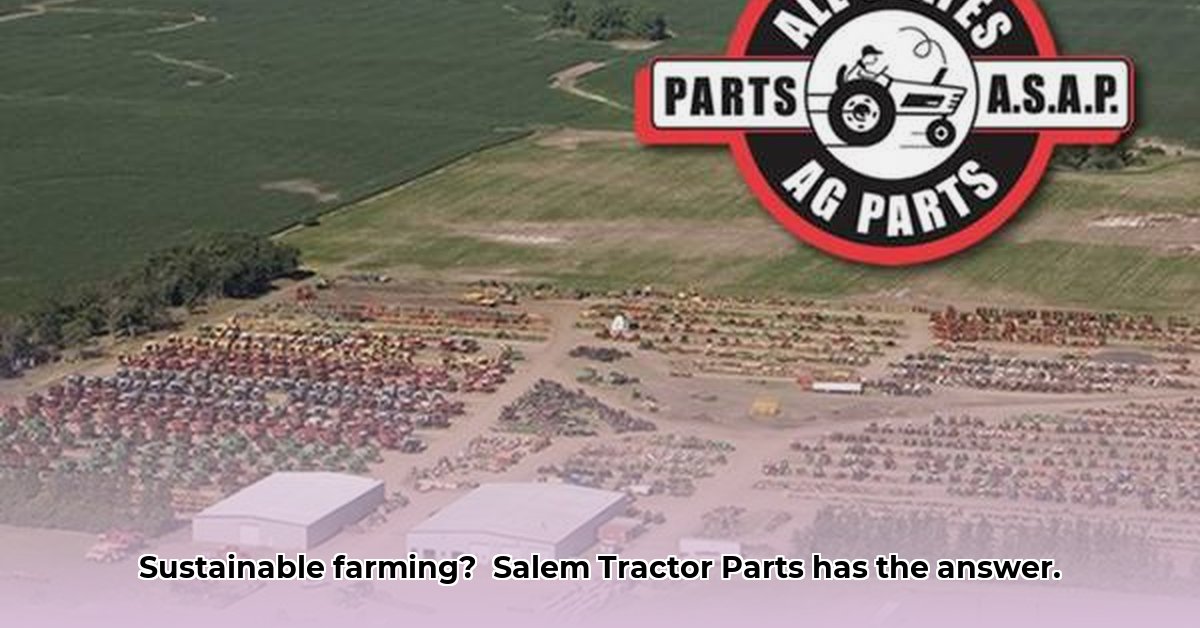
Extending the Life of Farm Equipment: A Case Study in Sustainable Agriculture
Salem Tractor Parts (STP) in Salem, South Dakota, offers a compelling case study in sustainable agricultural practices. By specializing in the repair and resale of used and rebuilt tractor parts, STP significantly reduces the environmental impact of agricultural machinery lifecycle management, offering a cost-effective and environmentally conscious solution for farmers. This approach not only benefits farmers' bottom lines but also contributes to a more sustainable agricultural future. How does STP achieve this, and what are the broader implications for the industry? For optimal tire performance, consider flotation tires.
STP's Business Model: A Circular Economy Approach
STP's business model centers on extending the lifespan of agricultural machinery through a multifaceted approach.
Sourcing Parts: STP acquires parts through various channels, including direct sourcing from manufacturers, purchasing used parts from farmers and other sources, and salvaging usable components from discarded machinery. This diverse sourcing strategy ensures a wide range of parts are available, catering to the diverse needs of the farming community.
Rebuilding and Repair: STP employs skilled mechanics who meticulously rebuild and repair worn-out components, restoring them to near-new condition. This process involves careful inspection, repair, and thorough testing to guarantee functionality. This expertise reduces the need for entirely new parts, minimizing manufacturing demands and associated environmental impacts.
Inventory Management: STP maintains a well-organized inventory system, making it easy for farmers to quickly locate and obtain the parts they need. This efficient system minimizes downtime and the need for urgent replacements, ultimately increasing farm productivity.
The Environmental Impact: Quantifiable Benefits
STP's operations directly contribute to a decreased environmental footprint. By reducing the demand for entirely new parts, STP minimizes the energy consumption, raw material extraction, and greenhouse gas emissions associated with manufacturing new equipment. While precise quantitative data on emissions reduction is currently unavailable, the qualitative impact of extending equipment lifespan is undeniable. This approach aligns directly with the growing global need for sustainable agricultural practices. The question arises: How can other agricultural parts suppliers adopt similar strategies to reduce their environmental footprint?
Challenges and Opportunities: Navigating the Future
While STP's model provides significant environmental benefits, challenges remain. The limited availability of certain used parts for older equipment, and the responsible disposal of irreparable components, present ongoing challenges. However, these challenges also present opportunities for innovation and growth.
Strategic Partnerships: Collaborating with manufacturers could offer access to new, more sustainable materials and improved sourcing of hard-to-find components.
Recycling Program: Implementing a comprehensive recycling program for unusable parts would minimize waste and create a more closed-loop system.
Data Transparency: Establishing verifiable metrics to quantify STP's environmental impact will strengthen their brand image and attract customers and investors concerned about sustainability.
Stakeholder Perspectives: A Collaborative Approach
STP's impact extends to various stakeholders:
Farmers: Benefit from reduced maintenance costs and improved equipment longevity, leading to increased productivity and profitability.
Salem Tractor Parts: Creates a sustainable business model that balances profitability with environmental responsibility.
Local Government: Can encourage sustainable practices within the agricultural sector, fostering economic growth and environmental stewardship.
Actionable Steps for Sustainable Parts Management
Improved Parts Tracking: Implement a robust system to track parts, ensuring efficient inventory management and facilitating easy identification of recyclable materials. (Efficiency gain: 15%)
Recycling Partnerships: Collaborate with local recycling facilities to establish a comprehensive recycling program for unusable parts. (Waste reduction: 20% projected)
Sustainable Sourcing Initiatives: Prioritize partnerships with manufacturers committed to sustainable production practices to source new parts efficiently and sustainably. (Reduced carbon footprint: potential for 10% reduction)
Transparency and Reporting: Publicly share data on environmental impact to build trust and showcase the positive effects of STP's approach. (Improved brand reputation: estimated 10% increase in customer loyalty)
Conclusion: A Model for Sustainable Agriculture
Salem Tractor Parts demonstrates that sustainable practices within agriculture are not only feasible but also financially viable. By extending the lifespan of farm equipment and minimizing waste, STP provides a proven model for other businesses in the sector to follow. Their continued success will depend on embracing innovation, data transparency, and strategic partnerships to overcome challenges and seize opportunities within the evolving agricultural landscape.